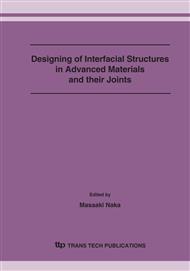p.295
p.301
p.307
p.313
p.319
p.325
p.331
p.337
p.343
Resistance Welding by Inserting Wires between Joint Interfaces
Abstract:
Butt resistance welding of super duplex stainless steel by inserting type 316L stainless steel wires was investigated. When the base material temperature was increased from room temperature to 1100 oC at the heating rate of 550 oC /sec, base materials were jointed through the insert wires and HAZ (heat affected zone) of the joint interface were less than 80 μm. In this joining technique, the insert wires played a role of concentrating current on the wires and increasing their temperature up to melting point or near melting point. When the welding was performed at a load of 10 N, the insert wires consisted of ferrite and austenite growing along the ferrite grain boundary. When the welding was performed at a load of 70N, insert wire remained austenite. That is because the contact resistance between insert wire and base materials at 70 N was lower than that of 10 N, and consequently the insert wire were not adequately heated.
Info:
Periodical:
Pages:
343-347
Citation:
Online since:
September 2007
Authors:
Price:
Сopyright:
© 2007 Trans Tech Publications Ltd. All Rights Reserved
Share:
Citation:


